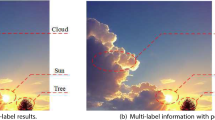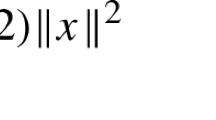Abstract
This paper presents a novel pairwise constraint propagation approach by decomposing the challenging constraint propagation problem into a set of independent semi-supervised classification subproblems which can be solved in quadratic time using label propagation based on \(k\)-nearest neighbor graphs. Considering that this time cost is proportional to the number of all possible pairwise constraints, our approach actually provides an efficient solution for exhaustively propagating pairwise constraints throughout the entire dataset. The resulting exhaustive set of propagated pairwise constraints are further used to adjust the similarity matrix for constrained spectral clustering. Other than the traditional constraint propagation on single-source data, our approach is also extended to more challenging constraint propagation on multi-source data where each pairwise constraint is defined over a pair of data points from different sources. This multi-source constraint propagation has an important application to cross-modal multimedia retrieval. Extensive results have shown the superior performance of our approach.














Similar content being viewed by others
References
Bartels, R., & Stewart, G. (1972). Solution of the matrix equation \({AX+XB=C}\). Communications of the ACM, 15(9), 820–826.
Basu, S., Bilenko, M., & Mooney, R. (2004). A probabilistic framework for semi-supervised clustering. In Proceedings of the SIGKDD (pp. 59–68).
Bekkerman, R., & Jeon, J. (2007). Multi-modal clustering for multimedia collections. In Proceedings of the CVPR (pp. 1–8).
Blei, D., Ng, A., & Jordan, M. (2003). Latent Dirichlet allocation. Journal of Machine Learning Research, 3, 993–1022.
Bruno, E., Moenne-Loccoz, N., & Marchand-Maillet, S. (2008). Design of multimodal dissimilarity spaces for retrieval of video documents. IEEE Transactions on Pattern Analysis and Machine Intelligence, 30(9), 1520–1533.
Carson, C., Belongie, S., Greenspan, H., & Malik, J. (2002). Blobworld: Image segmentation using expectation-maximization and its application to image querying. IEEE Transactions on Pattern Analysis and Machine Intelligence, 24(8), 1026–1038.
Chen, G., & Lerman, G. (2009). Spectral curvature clustering (scc). International Journal of Computer Vision, 81, 317–330.
Eaton, E., desJardins, M., & Jacob, S. (2010). Multi-view clustering with constraint propagation for learning with an incomplete mapping between views. In Proceedings of the ACM conference on information and knowledge management (CIKM) (pp. 389–398).
Eriksson, A., Olsson, C., & Kahl, F. (2007). Normalized cuts revisited: A reformulation for segmentation with linear grouping constraints. In Proceedings of the ICCV (pp. 1–8).
Farhadi, A., Hejrati, M., Sadeghi, M., Young, P., Rashtchian, C., Hockenmaier, J., et al. (2010). Every picture tells a story: Generating sentences from images. In Proceedings of the ECCV (Vol. 4, pp. 15–29).
Feng, S., Manmatha, R., & Lavrenko, V. (2004). Multiple Bernoulli relevance models for image and video annotation. In Proceedings of the CVPR (Vol. 2, pp. 1002–1009).
Gajic, Z., & Qureshi, M. (Eds.). (1995). Lyapunov matrix equation in system stability and control. New York: Academic Press.
Ghanem, B., & Ahuja, N. (2010). Dinkelbach NCUT: An efficient framework for solving normalized cuts problems with priors and convex constraints. International Journal of Computer Vision, 89(1), 40–55.
Hoi, S., Liu, W., Lyu, M., & Ma, W. Y. (2006). Learning distance metrics with contextual constraints for image retrieval. In Proceedings of the CVPR (pp. 2072–2078).
Hotelling, H. (1936). Relations between two sets of variates. Biometrika, 28(3–4), 321–377.
Hubert, L., & Arabie, P. (1985). Comparing partitions. Journal of Classification, 2(1), 193–218.
Kamvar, S., Klein, D., & Manning, C. (2003). Spectral learning. In Proceedings of the IJCAI (pp. 561–566).
Klein, D., Kamvar, S., & Manning, C. (2002). From instance-level constraints to space-level constraints: Making the most of prior knowledge in data clustering. In Proceedings of the ICML (pp. 307–314).
Kulis, B., Basu, S., Dhillon, I., & Mooney, R. (2005). Semi-supervised graph clustering: A kernel approach. In Proceedings of the ICML (pp. 457–464)..
Kulkarni, G., Premraj, V., Dhar, S., Li, S., Choi, Y., Berg, A., et al. (2011). Baby talk: Understanding and generating simple image descriptions. In Proceedings of the CVPR (pp. 1601–1608).
Lancaster, P. (1970). Explicit solutions of linear matrix equations. SIAM Review, 12(4), 544–566.
Law, M., Topchy, A., & Jain, A. (2004). Clustering with soft and group constraints. In Proceedings of the joint IAPR international workshop on structural, syntactic, and statistical pattern recognition (pp. 662–670).
Li, Z., Liu, J., & Tang, X. (2008). Pairwise constraint propagation by semidefinite programming for semi-supervised classification. In Proceedings of the ICML (pp. 576–583).
Li, J., & Wang, J. (2003). Automatic linguistic indexing of pictures by a statistical modeling approach. IEEE Transactions on Pattern Analysis and Machine Intelligence, 25(9), 1075–1088.
Liu, W., Ma, S., Tao, D., Liu, J., & Liu, P. (2010). Semi-supervised sparse metric learning using alternating linearization optimization. In Proceedings of the KDD (pp. 1139–1148).
Lu, Z., & Carreira-Perpinan, M. (2008). Constrained spectral clustering through affinity propagation. In Proceedings of the CVPR.
Lu, Z., & Ip, H. (2009). Image categorization by learning with context and consistency. In Proceedings of the CVPR (pp. 2719–2726).
Lu, Z., & Ip, H. (2010). Constrained spectral clustering via exhaustive and efficient constraint propagation. In Proceedings of the ECCV (Vol, 6, pp. 1–14).
Lu, Z., Ip, H., & Peng, Y. (2011). Contextual kernel and spectral methods for learning the semantics of images. IEEE Transactions on Image Processing, 20(6), 1739–1750.
Lu, Z., Peng, Y., & Xiao, J. (2008). From comparing clusterings to combining clusterings. In Proceedings of the AAAI (pp. 665–670).
Ng, A., Jordan, M., & Weiss, Y. (2002). On spectral clustering: Analysis and an algorithm. Advances in Neural Information Processing Systems, 14, 849–856.
Oliva, A., & Torralba, A. (2001). Modeling the shape of the scene: A holistic representation of the spatial envelope. International Journal of Computer Vision, 42(3), 145–175.
Ordonez, V., Kulkarni, G., & Berg, T. (2012). Im2Text: Describing images using 1 million captioned photographs. Advances in Neural Information Processing Systems, 24, 1143–1151.
Rasiwasia, N., Costa Pereira, J., Coviello, E., Doyle, G., Lanckriet, G., Levy, R., et al. (2010). A new approach to cross-modal multimedia retrieval. In Proceedings of the ACM multimedia (pp. 251–260).
Rasiwasia, N., Moreno, P., & Vasconcelos, N. (2007). Bridging the gap: Query by semantic example. IEEE Transactions on Multimedia, 9(5), 923–938.
Shi, J., & Malik, J. (2000). Normalized cuts and image segmentation. IEEE Transactions on Pattern Analysis and Machine Intelligence, 22(8), 888–905.
Snoek, C., & Worring, M. (2005). Multimodal video indexing: A review of the state-of-the-art. Multimedia Tools and Applications, 25(1), 5–35.
Veksler, O. (2008). Star shape prior for graph-cut image segmentation. In Proceedings of the ECCV (pp. 454–467).
von Luxburg, U. (2007). A tutorial on spectral clustering. Statistics and Computing, 17(4), 395–416.
Wagstaff, K., Cardie, C., Rogers, S., & Schroedl, S. (2001). Constrained k-means clustering with background knowledge. In Proceedings of the ICML (pp. 577–584).
Xing, E., Ng, A., Jordan, M., & Russell, S. (2003). Distance metric learning with application to clustering with side-information. Advances in Neural Information Processing Systems, 15, 505–512.
Xu, L., Li, W., & Schuurmans, D. (2009). Fast normalized cut with linear constraints. In Proceedings of the CVPR (pp. 2866–2873).
Yu, S., & Shi, J. (2004). Segmentation given partial grouping constraints. IEEE Transactions on Pattern Analysis and Machine Intelligence, 26(2), 173–183.
Zhou, D., Bousquet, O., Lal, T., Weston, J., & Schölkopf, B. (2004). Learning with local and global consistency. Advances in Neural Information Processing Systems, 16, 321–328.
Zhu, X., Ghahramani, Z., & Lafferty, J. (2003). Semi-supervised learning using Gaussian fields and harmonic functions. In Proceedings of the ICML (pp. 912–919).
Acknowledgments
The authors would like to thank Liwei Wang, Zhenyong Fu, and the anonymous reviewers for their valuable comments. This work was supported by National Natural Science Foundation of China under Grants 61073084 and 61202231, Beijing Natural Science Foundation of China under Grant 4122035, National Hi-Tech Research and Development Program (863 Program) of China under Grant 2012AA012503, National Development and Reform Commission High-tech Program of China under Grant [2010]3044, and National Key Technology Research and Development Program of China under Grant 2012BAH07B01.
Author information
Authors and Affiliations
Corresponding author
Rights and permissions
About this article
Cite this article
Lu, Z., Peng, Y. Exhaustive and Efficient Constraint Propagation: A Graph-Based Learning Approach and Its Applications. Int J Comput Vis 103, 306–325 (2013). https://doi.org/10.1007/s11263-012-0602-z
Received:
Accepted:
Published:
Issue Date:
DOI: https://doi.org/10.1007/s11263-012-0602-z




